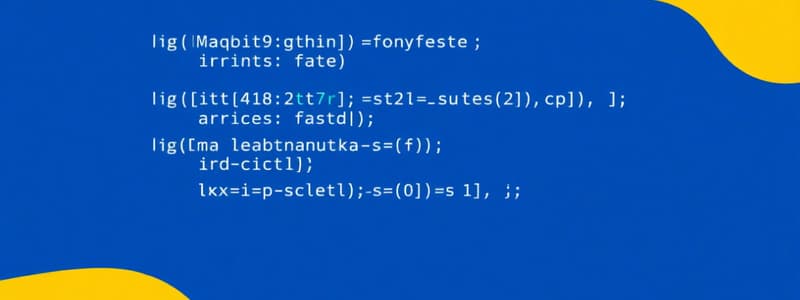Podcast
Questions and Answers
What is the definition of a string in programming?
What is the definition of a string in programming?
- A group of characters (correct)
- A function that returns text
- A type of variable that holds boolean values
- A collection of numeric values
Which statement about strings is true?
Which statement about strings is true?
- Strings can include numbers and special characters. (correct)
- Strings in single quotes are different from those in double quotes.
- Strings can contain only alphabetic characters.
- Strings cannot be empty.
How would you represent the string 'HELLO' using single quotes?
How would you represent the string 'HELLO' using single quotes?
- [HELLO]
- 'HELLO' (correct)
- 'H E L L O'
- HELLO[]
What is the relationship between strings written in single quotes and double quotes?
What is the relationship between strings written in single quotes and double quotes?
Which of the following options is NOT a characteristic of strings?
Which of the following options is NOT a characteristic of strings?
What is the primary purpose of the instructions provided in Lab0?
What is the primary purpose of the instructions provided in Lab0?
Who is credited with providing the instructions for installing the Python IDE?
Who is credited with providing the instructions for installing the Python IDE?
What does IDE stand for in the context of programming?
What does IDE stand for in the context of programming?
Which of the following might you expect to learn from Lab0 in relation to the Python IDE?
Which of the following might you expect to learn from Lab0 in relation to the Python IDE?
Why is it important to install an IDE for Python before programming?
Why is it important to install an IDE for Python before programming?
What will be the output of the expression print(a>1 or b>1) when a=4 and b=5?
What will be the output of the expression print(a>1 or b>1) when a=4 and b=5?
Which logical operator is used to combine two boolean expressions in the example given?
Which logical operator is used to combine two boolean expressions in the example given?
If the values of a and b were switched to a=0 and b=3, what would be the output of print(a>1 or b>1)?
If the values of a and b were switched to a=0 and b=3, what would be the output of print(a>1 or b>1)?
What effect does the logical NOT operator have on the expression b>1?
What effect does the logical NOT operator have on the expression b>1?
What will be the result of the expression print(not (a>1)) if a=4?
What will be the result of the expression print(not (a>1)) if a=4?
What is the output of the following code? 'print('I study at {0} {1} and I am {2} years old.'.format(Uni_name_1,Uni_name_2,Age))'
What is the output of the following code? 'print('I study at {0} {1} and I am {2} years old.'.format(Uni_name_1,Uni_name_2,Age))'
Which of the following correctly initializes the variables used in the format method?
Which of the following correctly initializes the variables used in the format method?
What will happen if the format method is called with fewer arguments than placeholders?
What will happen if the format method is called with fewer arguments than placeholders?
In the output statement, which placeholder corresponds to the variable 'Age'?
In the output statement, which placeholder corresponds to the variable 'Age'?
What will be the output if Age is changed to 25 before executing the print statement?
What will be the output if Age is changed to 25 before executing the print statement?
What is the correct order of the variables used in the format method?
What is the correct order of the variables used in the format method?
What would be the output if the variables were defined as: Age = 20, Uni_name_1 = 'Harvard', Uni_name_2 = 'University'?
What would be the output if the variables were defined as: Age = 20, Uni_name_1 = 'Harvard', Uni_name_2 = 'University'?
Which statement correctly describes the behavior of the .format() method?
Which statement correctly describes the behavior of the .format() method?
If Uni_name_1 is set to 'Stanford' and Age to 21, how would the output change?
If Uni_name_1 is set to 'Stanford' and Age to 21, how would the output change?
What is the purpose of using '{0}', '{1}', and '{2}' in the print statement?
What is the purpose of using '{0}', '{1}', and '{2}' in the print statement?
Flashcards are hidden until you start studying
Study Notes
String Formatting
- String formatting can be done with the
.format()method - Example:
print('I study at {0} {1} and I am {2} years old.'.format(Uni_name_1, Uni_name_2, Age))
- Output:
I study at Khalifa University and I am 18 years old.
Literal Constants: Strings
- A string is a collection of characters
- Can be written using single quotes (
'HELLO') or double quotes ("HELLO") - Strings in double quotes are identical to strings in single quotes
Python IDE
- Use the IDE provided in Lab0 to run Python code.
- Example:
a = 4b = 5print(a > 1 or b > 1)
- Output:
True
Logical Operators
- The Logical NOT operator takes a single expression and negates the value.
- The Logical AND operator combines two or more expressions using the
andkeyword. - The Logical OR operator combines two or more expressions using the
orkeyword.
.format() Method
- The
.format()method can be used to format strings. - The order of arguments in the
.format()method does not need to match the order in the string. - Example:
print('I study at {2} {0} and I am {1} years old.'.format(Uni_name_1, Uni_name_2, Age))
- This will print:
I study at 18 Khalifa and I am University years old.
Studying That Suits You
Use AI to generate personalized quizzes and flashcards to suit your learning preferences.




